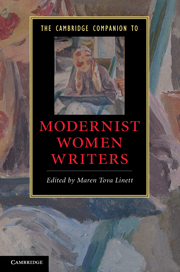Book contents
- Frontmatter
- Modernist women’s literature: an introduction
- 1 Transforming the novel
- 2 Modernist women poets and the problem of form
- 3 Women’s modernism and performance
- 4 Magazines, presses, and salons in women’s modernism
- 5 Gender in women’s modernism
- 6 Black women’s modernist literature
- 7 Race and ethnicity in white women’s modernist literature
- 8 Geomodernism, postcoloniality, and women’s writing
- 9 Women modernists and visual culture
- 10 Modernism and trauma
- 11 Political activism and women’s modernism
- 12 Religion and the occult in women’s modernism
- Guide to further reading
- Index
6 - Black women’s modernist literature
Published online by Cambridge University Press: 28 November 2010
- Frontmatter
- Modernist women’s literature: an introduction
- 1 Transforming the novel
- 2 Modernist women poets and the problem of form
- 3 Women’s modernism and performance
- 4 Magazines, presses, and salons in women’s modernism
- 5 Gender in women’s modernism
- 6 Black women’s modernist literature
- 7 Race and ethnicity in white women’s modernist literature
- 8 Geomodernism, postcoloniality, and women’s writing
- 9 Women modernists and visual culture
- 10 Modernism and trauma
- 11 Political activism and women’s modernism
- 12 Religion and the occult in women’s modernism
- Guide to further reading
- Index
Summary
Although the shift into a modern mode happened for all African Americans with Emancipation, the major turn to modernist literature for African American women occurred with the second generation to come of age after the end of slavery. For these women born just before or just after the turn of the twentieth century, literature was more often an avocation than a vocation. The economic pressures on all descendants of enslaved people and the social strictures separating blacks into ever more limited spaces meant that a career as a writer was virtually an impossibility, yet black women persisted in writing, and in doing so with an acute consciousness of their raced and gendered location in a social ground constituted out of spatial and relational structures. The all-important room of one's own that Virginia Woolf desired for herself and other women artists in her era, black women writers during this same period configured simply as “elbow room,” by which they placed an added emphasis on the body itself. During the New Negro or Harlem Renaissance, a progressive period for African American writers following the First World War, Georgia Douglas Johnson publicly spoke of that small space when she was featured in Opportunity Magazine's 1927 “Contest Spotlight”: “I write because I love to write . . . If I might ask of some fairy godmother special favors, one would sure be for a clearing space, elbow room in which to think and write and live beyond the reach of the Wolf's fingers. However, much that we do and write about comes just because of the daily struggle for bread and breath - so perhaps it's just as well.”
- Type
- Chapter
- Information
- The Cambridge Companion to Modernist Women Writers , pp. 95 - 109Publisher: Cambridge University PressPrint publication year: 2010



